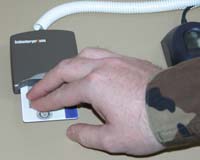| . |  |
. |
Paris (AFP) Aug 11, 2009 Sequencing the first human genome cost billions and required an army of scientists, but now a trio of researchers in the United States have matched that feat for the price mid-range BMW, according to a study published Monday. "This can be done in one lab, with one machine, and at a modest cost" of about 50,000 dollars (36,000 euros), said Stanford University professor Stephen Quake, who designed the study and lent his DNA for the task. At the close of the 20th century, piecing together a complete map of a genome -- the blueprint of human life itself spread across three-billion pairs of molecules -- was the all-consuming Manhattan Project of biotechnology. The achievement, unveiled in draft form in 2001 and finished in 2003, was hailed as one of humanity's major scientific achievements. Since then, sequencing "has become an order of magnitude cheaper and faster" every couple of years, said Lynda China, a medical researcher at the Dana-Farber Cancer Institute in Boston. In 2007, the firm 454 Life Sciences did it in under three months and for less than a million dollars. In September that year, scientific maverick Craig Venter published his own complete DNA code, the first of a single individual rather than an amalgam from multiple sources. Cost: not disclosed. Last year, the price dropped to a quarter of a million, but still needed the input of dozens of experts. The new breakthrough, reported in the journal Nature Biotechnology, has become the latest benchmark. Even if only a dozen or so individual genomes have been sequenced to date, the process is on the verge of becoming commonplace and could, within a few years, cost even ten times less. One biotech start-up, Pacific Biosciences in Menlo Park, vows that by 2013 it will be able to unpack a complete DNA in a quarter of an hour for under a thousand dollars. A legion of potential applications are driving the research, ranging from "personalised medicine" tailored to your genetic profile, to exploring the earliest dawn of human evolution in the DNA of our ancestors' fossils. Quake discovered, for example, that he carries a rare genetic mutation associated with a heart disorder. He also learned that he is likely to respond well to cholesterol-lowering statin drugs that could help prevent heart disease. Complete sequencing is not to be confused with the gene kits offered by companies such as 23andMe or deCODEme, which offer only snapshots of DNA, not the whole shebang. "It's really democratising the fruits of the genome revolution and saying that anybody can play in this game," Quake said in a statement. Using a single fridge-sized machine and a process called single molecule sequencing, Quake and his colleagues diced up the more than three billion molecular pairings of the human DNA into millions of strands. The four molecular building blocks of DNA are adenine (A), cytosine (C), guanine (G), and thymine (T). The machine read each strand with the help of florescent markers, and then its powerful computers reassembled them back into a cohesive genome. "It's like assembling an enormous jigsaw puzzle by referring frequently to the picture on the box," Quake said, alluding to the reference genome held by the US National Center for Biotechnology Information. Overall, Quake's genome is 95 percent complete, on a par with earlier efforts. Share This Article With Planet Earth
Related Links All About Human Beings and How We Got To Be Here
 Swiss artist fights biometric passport
Swiss artist fights biometric passportBerlin (UPI) Aug 7, 2009 From his self-chosen exile in Berlin, a Swiss-born artist has been battling Switzerland's decision to introduce a biometric passport. Adam Tellmeister places the scalpel on his brand new Swiss passport and cuts right through its blood-red outer fabric. It's the first cut of an operation -- broadcast live on the Internet -- that is aimed at removing the chip from his new biometric passpo ... read more |
|
| The content herein, unless otherwise known to be public domain, are Copyright 1995-2009 - SpaceDaily. AFP and UPI Wire Stories are copyright Agence France-Presse and United Press International. ESA Portal Reports are copyright European Space Agency. All NASA sourced material is public domain. Additional copyrights may apply in whole or part to other bona fide parties. Advertising does not imply endorsement,agreement or approval of any opinions, statements or information provided by SpaceDaily on any Web page published or hosted by SpaceDaily. Privacy Statement |